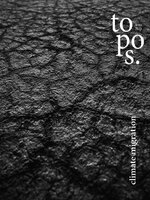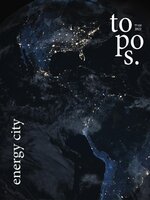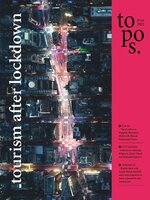Topos is a must-have for successful landscape architects, planners, urban designers and architects all over the world.The monothematic issues provide a global overview of innovative projects, new developments and trends in the profession. Be part of the worldwide community of Topos readers!
Editorial
Shipwrecked • Placed in the middle of the mysterious ebony river Grijalva, long vertical lines shift up to build thick textured walls that, seen from above, would appear as an ichnographic plan extruded from paper. Wide open arches lead into bleak emptiness. There is no way to set foot on the floor that once was there, only streams of water passing through this old building’s skin. Mexican photographer and filmmaker Santiago Arau, who is recognized primarily for his work with drones, captures the atmosphere of this place in a sublime way: the sixteenth-century Temple of Santiago, located in Quechula, Mexico, was abandoned two hundred years after its construction due to a plague. As part of the contemporary vision of progress which includes the need for energy, the Nezahualcóyotl Dam, also known as Malpaso Dam, was built in the 1960s, flooding and completely crumbling this neglected place, leaving it submerged in oblivion for decades. In 2015, due to a drought, the water receded and allowed this sanctuary to rise again. Appearing as a wrecked ship, it accidentally became an open chapel, acquiring the power to make the sky above it seem wider. While constantly trying to distinguish and separate themselves from nature, human beings forget they are an indisputable and inevitable part of it. Immersed in ourselves as species, we play with our surroundings. Regardless of whether it is architecture or living beings at stake, there is always space for humans to try to impose their power over the territory. But nature is resilient and always finds its own way to take over again, gently appropriating it. The forsaken Temple of Santiago, which could have become a symbol of human’s selfishness, turned into a home to nature. It is water that now inhabits it, envelops it, borders it, making it yet another element inside the unseen and assumed landscape.
Laura von Puttkamer Urban Development Specialist • Social housing is urgently needed in many countries. But how can we provide affordable housing in low-income environments? 3D printing offers a potential solution for housing inequality.
Martin Henn • Martin Henn completed his architectural studies at the University of Stuttgart as well as at the ETH Zurich, where he graduated with a Master’s degree in 2006. In 2008, he received a Master of Advanced Architectural Design from Columbia University in New York. Prior to HENN, he worked at Zaha Hadid Architects in London and Asymptote Architecture in New York. Martin Henn joined HENN in 2008, becoming a partner in 2012 and managing director in 2017. As Head of Design he leads the design studios in Berlin, Munich and Beijing.
Gunter Henn • German architect Gunter Henn founded his architectural practice in Munich in 1979. Today HENN is a globally active company with offices in Munich, Berlin and Beijing and renowned especially for its industry and office buildings. For Gunter Henn forms and spaces need to be developed from the processes, demands and cultural contexts of each project. Gunter Henn held the Chair of Industrial and Research Buildings at the Technical University of Dresden from 2000 to 2015 and was a visiting professor at the Massachusetts Institute of Technology (MIT) in Boston from 1994 to 2000.
Vilnius
Temperatures of Urbanity • How to approach fringes? How to approach a zone of transition, a short-distanced difference, an in-betweenness charged with opportunities? In fact, these territories of uncertainty inherit a certain kind of urbanity, albeit they resist classifications such as peripheral or sub-/peri-urban. However, fringe territories...

 N. 132
N. 132
 N. 131
N. 131
 N. 130
N. 130
 N. 129
N. 129
 N. 128
N. 128
 N. 127
N. 127
 N. 126
N. 126
 N. 125
N. 125
 N. 124
N. 124
 N. 123
N. 123
 N. 122
N. 122
 N. 121
N. 121
 N. 120
N. 120
 N. 119
N. 119
 N. 118
N. 118
 N. 117
N. 117